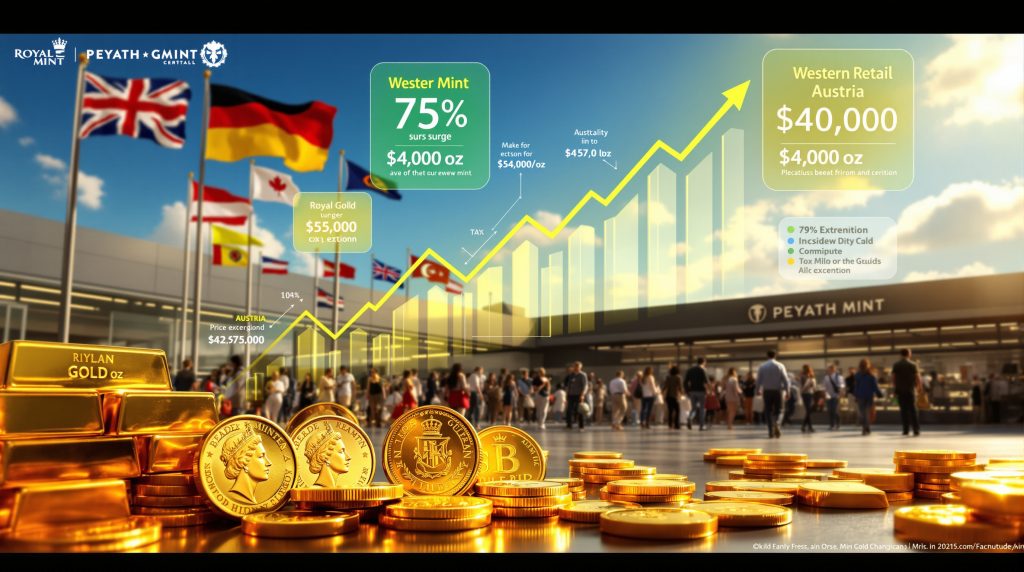Understanding the Current Gold Rush Among Western Investors
The precious metals market has witnessed an extraordinary transformation in 2025, with western retail demand for gold reaching levels that challenge conventional investment wisdom. Physical gold purchasing has surged dramatically across major international mints, creating supply chain pressures and operational challenges not seen in decades.
Furthermore, Perth Mint has experienced a remarkable 75% increase in visitor traffic, with weekly footfall rising from 5,000 to 8,750 customers over a four-week period. This surge has necessitated immediate operational adjustments, including the recruitment of eight additional staff members across retail and customer service departments.
Market demographics reveal a fascinating split in customer behavior. Current data shows 60% of purchasers are existing precious metals investors, while 40% represent entirely new market participants. This distribution suggests both portfolio expansion among experienced investors and fresh capital inflows from previously uninvolved retail participants.
The economic uncertainty driving this phenomenon extends beyond traditional safe-haven considerations. Global instability has created an environment where tangible assets provide psychological comfort alongside potential financial protection. In addition, rising geopolitical tensions have amplified gold's appeal as a hedge against currency devaluation and systemic financial risks.
Price Performance vs. Demand Correlation
Gold's price trajectory throughout 2025 defies typical demand elasticity patterns. Despite achieving record highs of $4,381 per ounce and maintaining year-to-date gains of 55%, retail purchasing activity continues accelerating rather than moderating. This demonstrates how gold as an inflation hedge remains attractive even at elevated prices.
This phenomenon challenges traditional economic models where higher prices typically reduce consumer demand. The precious metals market appears to operate under different psychological principles, where price appreciation reinforces rather than diminishes investment conviction.
Historical analysis reveals that previous gold bull markets experienced similar patterns during peak phases. However, the current cycle demonstrates unusual sustainability, with prices having doubled over the past two years while retail participation expanded rather than contracted.
Even following a significant 7% selloff that brought prices down to approximately $4,076 per ounce, retail demand has shown remarkable resilience. Local dealers report customers expressing confidence that current price levels represent opportunities rather than overvaluation, reflecting the ongoing gold market price surge.
Which Regions Are Leading the Western Gold Buying Surge?
United Kingdom's Tax-Efficient Investment Strategies
Britain's precious metals market has become increasingly sophisticated, with investors leveraging specific tax advantages to optimise their gold holdings. The Royal Mint has recorded its strongest single day of e-commerce trading in October 2025, highlighting the digital transformation of precious metals purchasing.
London's historic Hatton Garden district exemplifies this shift. Traditionally dominated by diamond trading, the area now buzzes with gold bullion activity as investors seek both bars and coins. This geographical transformation reflects broader market dynamics where precious metals have gained prominence over traditional luxury investments.
UK investors demonstrate particular sophistication in navigating Capital Gains Tax regulations. British Sovereigns and Britannias, classified as legal tender, provide complete CGT exemption advantages over gold bars, which remain subject to standard capital gains taxation.
Customer behaviour patterns reveal strategic tax planning approaches. Investors actively convert bar holdings into coin formats to eliminate future tax liabilities whilst maintaining precious metals exposure. This strategy allows portfolio optimisation without sacrificing long-term wealth preservation objectives.
Continental European Market Dynamics
Germany and Austria have emerged as particularly robust markets for physical gold investment. Vienna's precious metals retailers report unprecedented customer queues at both Ögussa shops and Austrian Mint locations throughout the city centre.
German precious metals dealers describe similar scenes, with retail locations experiencing sustained high-volume traffic. This continental European demand surge appears driven by similar safe-haven motivations but manifests through different purchasing patterns compared to British markets.
Regional variations in preferred investment formats reflect local regulatory environments and cultural preferences. European investors demonstrate strong preferences for internationally recognised bullion products, particularly those with established liquidity profiles across multiple markets.
The continental European surge also reveals infrastructure adaptations, with established dealers expanding operational capacity to accommodate increased customer volumes. This expansion suggests market participants expect sustained elevated demand rather than temporary speculative activity.
How Are Major Mints Responding to Explosive Retail Demand?
Royal Mint's Record-Breaking E-commerce Performance
The Royal Mint's digital transformation has proven crucial during the current demand surge. E-commerce platforms have handled exceptional transaction volumes, with October 2025 setting new single-day trading records across all precious metals categories.
Customer transaction analysis reveals significant changes in purchasing patterns. Existing investors are substantially increasing average order values whilst expanding their positions despite elevated price levels. This behaviour suggests confidence in long-term precious metals appreciation rather than short-term speculation.
| Customer Segment | Percentage of Sales | Behaviour Pattern |
|---|---|---|
| Existing Investors | 60% | Increasing order values, doubling positions |
| New Customers | 40% | Entry-level purchases, learning curve adoption |
| Average Transaction | Not specified | Significantly above historical norms |
The mint's operational response includes enhanced digital infrastructure and expanded customer service capabilities. These investments reflect expectations that elevated demand levels represent structural rather than cyclical market changes.
Perth Mint's Operational Expansion
Perth Mint's physical retail operations have undergone rapid scaling to accommodate unprecedented visitor volumes. The 75% increase in weekly traffic from 5,000 to 8,750 customers has necessitated comprehensive operational adjustments.
Workforce expansion has focused on customer-facing roles, with eight new staff members recruited specifically for retail and customer operations. This hiring surge reflects both immediate capacity needs and strategic positioning for continued high-volume operations.
Infrastructure adaptations extend beyond staffing to include enhanced security protocols, expanded display areas, and improved customer flow management. These changes suggest institutional preparation for sustained rather than temporary demand elevation.
The Perth Mint experience provides valuable insights into operational challenges facing precious metals retailers globally. Supply chain coordination, inventory management, and customer service scaling represent critical success factors during demand surges.
What Investment Strategies Are Western Retail Buyers Adopting?
Physical vs. Paper Gold Preferences
World Gold Council data reveals nuanced shifts in precious metals investment preferences throughout 2024. Investment demand for gold bars increased 10%, whilst coin purchases declined 32%, suggesting strategic repositioning among retail investors. This aligns with broader gold investment strategies being adopted across Western markets.
This divergence reflects several underlying factors:
- Liquidity considerations: Bars offer easier resale transactions in institutional markets
- Storage efficiency: Higher gold content per storage unit reduces vault costs
- Premium optimisation: Bars typically carry lower premiums over spot prices
- Tax planning: Varies by jurisdiction, with some regions favouring bars over coins
However, regional variations complicate this trend analysis. UK markets show continued strong coin demand due to CGT advantages, whilst continental European markets demonstrate stronger bar preferences aligned with traditional investment approaches.
Portfolio Diversification Approaches
Existing precious metals investors demonstrate sophisticated portfolio management strategies during the current market cycle. Rather than reducing exposure during price peaks, established investors are doubling down on their positions through increased order values.
This behaviour suggests several strategic considerations:
- Wealth preservation focus: Long-term purchasing power protection outweighs short-term price volatility concerns
- Portfolio rebalancing: Precious metals allocation increases to maintain target percentages during other asset class volatility
- Dollar-cost averaging: Systematic accumulation approaches regardless of current price levels
- Generational wealth transfer: Acquisition strategies incorporating inheritance and estate planning objectives
New market participants demonstrate different behavioural patterns, typically starting with smaller positions whilst learning market dynamics. This education phase often leads to expanded positions as investors gain confidence and market knowledge.
How Do Tax Implications Shape Western Gold Investment Decisions?
United Kingdom's CGT Framework Impact
British investors have developed sophisticated tax optimisation strategies that significantly influence precious metals investment decisions. The fundamental distinction between gold bars and coins creates powerful planning opportunities for wealth preservation.
Tax Strategy Insight: Converting gold bars to legal tender coins eliminates Capital Gains Tax obligations entirely, providing significant advantages for long-term wealth preservation strategies.
Practical implementation involves strategic timing and format selection. Investors maintaining two-thirds of holdings whilst selling one-third demonstrate balanced approaches between realising gains and maintaining precious metals exposure for future appreciation.
The legal tender classification system creates unique advantages for British investors compared to other Western markets. Sovereigns and Britannias receive full CGT exemption, making them preferred vehicles for tax-efficient precious metals accumulation.
Cross-Border Tax Efficiency Strategies
Continental European markets operate under different tax frameworks that influence investment format preferences. German and Austrian investors face varying VAT and capital gains treatment depending on product types and holding periods.
These regulatory differences create arbitrage opportunities for sophisticated investors willing to navigate cross-border considerations. However, complexity increases substantially when incorporating multiple jurisdictions into precious metals planning strategies.
Professional advisory services have evolved to address these complexities, with specialised consultants focusing exclusively on precious metals tax optimisation across Western markets. This specialisation reflects growing demand for sophisticated planning approaches.
What Economic Factors Are Fueling This Retail Gold Phenomenon?
Geopolitical Uncertainty Drivers
The current precious metals surge reflects broader global instability that extends beyond traditional economic indicators. Rising geopolitical tensions have amplified gold's safe-haven appeal among retail investors seeking portfolio protection.
Global uncertainty manifests through multiple channels affecting investor psychology:
- Currency devaluation concerns: Major fiat currencies face unprecedented monetary policy challenges
- Systemic financial risks: Banking sector stability questions drive hard asset preference
- Supply chain disruptions: Physical goods scarcity increases tangible asset appeal
- Political instability: Governance challenges across Western democracies create uncertainty
Market analysts characterise the current environment as deeply unsettled, with gold reflecting these broader instability patterns through sustained price appreciation and retail demand growth.
Inflation Hedge Positioning
Western retail demand for gold increasingly reflects inflation protection strategies as traditional investment approaches face purchasing power erosion risks. Real return analysis comparing gold to conventional assets reveals precious metals' effectiveness during inflationary periods.
Historical precedents demonstrate gold's utility as purchasing power preservation during currency debasement cycles. Current market conditions exhibit similar characteristics to previous inflationary episodes that favoured hard asset allocation strategies.
However, measuring real returns requires sophisticated analysis incorporating opportunity costs, storage expenses, and tax implications. Professional investors increasingly utilise comprehensive modelling approaches to optimise precious metals allocation within diversified portfolios.
Are Current Western Retail Gold Trends Sustainable Long-Term?
Market Analyst Projections
Industry professionals express cautious optimism regarding sustained retail precious metals demand. Physical gold appears positioned to remain a key portfolio component in the months ahead for investors prioritising security and liquidity. Furthermore, gold price forecast trends suggest continued upward momentum.
Expert analysis suggests current trends reflect structural rather than cyclical market changes. The expansion from traditional precious metals investors to new retail participants indicates broader market evolution rather than temporary speculation.
However, sustainability depends on multiple factors:
- Economic uncertainty persistence: Continued geopolitical and financial instability
- Price accessibility: Ability for new investors to participate at elevated price levels
- Infrastructure capacity: Dealer and mint ability to service expanded customer bases
- Alternative investment performance: Relative attractiveness compared to traditional assets
Potential Market Saturation Indicators
Whilst current demand appears robust, several factors could signal potential cooling in western retail demand for gold. Price level thresholds may eventually impact retail affordability, particularly for new market participants with limited capital.
Market saturation risks include:
- Affordability constraints: Higher prices reducing accessible investment amounts
- Infrastructure limitations: Dealer capacity constraints during peak demand periods
- Alternative investment opportunities: Other assets offering superior risk-adjusted returns
- Regulatory changes: Tax or legal modifications affecting investment attractiveness
Monitoring these indicators provides early warning systems for potential demand moderation, though current market dynamics suggest sustained strength in the near term.
Frequently Asked Questions About Western Retail Gold Demand
Why are people buying gold at record-high prices?
Retail investors continue purchasing precious metals despite elevated prices due to several compelling factors. Safe-haven appeal during global uncertainty provides psychological comfort that outweighs short-term price considerations for many investors.
Wealth preservation motivations transcend current valuations when investors focus on long-term purchasing power protection. Many customers express confidence that current price levels represent stepping stones toward significantly higher future valuations.
Future price appreciation expectations among retail investors reflect analysis of monetary policy trends, geopolitical developments, and currency devaluation risks. These macro factors suggest continued precious metals appreciation potential despite current elevated levels.
Which gold investment formats offer the best value for Western buyers?
Tax-efficient options vary significantly across Western markets, making format selection crucial for optimising investment returns. British investors benefit substantially from legal tender coin advantages, whilst continental Europeans may prefer bars for liquidity reasons.
Comparison of Investment Formats:
| Format | UK Advantages | Continental European Benefits | Liquidity Considerations |
|---|---|---|---|
| Legal Tender Coins | CGT exemption | Cultural preference | High retail liquidity |
| Gold Bars | Lower premiums | Institutional acceptance | Professional market access |
| Numismatic Coins | Collection value | Historical significance | Specialised market required |
Storage and insurance cost analysis reveals additional considerations affecting format selection. Larger bars offer storage efficiency advantages, whilst coins provide flexibility for partial position liquidation strategies.
How can new investors participate in the current gold market?
Entry-level investment strategies should emphasise education and gradual position building rather than large initial commitments. Reputable dealer selection requires verification of licensing, insurance coverage, and established track records.
Risk management approaches for volatile precious metals markets include:
- Dollar-cost averaging: Regular small purchases reduce timing risk
- Storage planning: Secure vault services or allocated storage solutions
- Insurance coverage: Protection against theft or loss risks
- Exit strategy planning: Clear objectives for profit-taking or loss limitation
New investors should prioritise understanding tax implications, storage requirements, and liquidity characteristics before committing significant capital to precious metals investments.
Strategic Implications for Western Precious Metals Markets
Long-Term Market Structure Changes
The current retail investor base expansion creates fundamental shifts in precious metals market dynamics. Traditional institutional dominance faces dilution as retail participation grows, potentially reducing price volatility through broader ownership distribution.
Distribution channel evolution accommodates increased demand through enhanced digital platforms and expanded physical retail presence. Hatton Garden's transformation from diamond focus toward bullion prominence exemplifies broader industry adaptations.
Technology integration improves precious metals accessibility through streamlined e-commerce platforms, mobile applications, and automated investment services. These innovations lower barriers to entry whilst improving customer experience quality.
Investment Industry Adaptations
Product innovation addresses retail precious metals preferences through diversified offerings, flexible investment sizes, and enhanced storage solutions. Service enhancement trends among bullion dealers focus on customer education and ongoing portfolio guidance.
Educational resource development supports the growing investor base through comprehensive market analysis, technical education, and strategic planning guidance. This educational emphasis helps sustain long-term market participation rates.
Consequently, professional advisory services have evolved to address increasing complexity in precious metals planning, offering specialised expertise in tax optimisation, storage solutions, and portfolio integration strategies.
Disclaimer: This analysis involves forecasts and market speculation that may not reflect actual future performance. Precious metals investments carry inherent risks including price volatility, storage costs, and liquidity considerations. Investors should conduct thorough research and consider professional advisory services before making significant precious metals commitments.
Looking to Capitalise on Gold Market Opportunities?
Discovery Alert's proprietary Discovery IQ model delivers real-time notifications on significant ASX mineral discoveries, empowering subscribers to identify actionable opportunities in gold and other commodities ahead of the broader market. Explore why historic discoveries can generate substantial returns and begin your 30-day free trial today to secure your market-leading advantage.




